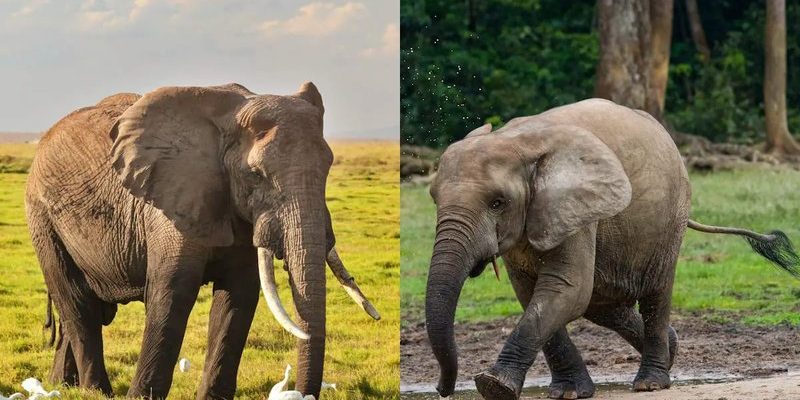![Comparing The African Forest Elephant Vs. [Similar Species]](https://gudri.com/wp-content/uploads/2025/06/Comparing_The_African_Forest_Elephant_Vs___Similar_Species__image_0.jpg)
Understanding these magnificent animals is more than just an interesting fact—it’s important for conservation efforts and appreciating the diversity of wildlife on our planet. So grab your favorite coffee, and let’s dive into the world of African elephants!
Physical Characteristics
When you think of elephants, you might picture a large, gray creature with floppy ears and a long trunk. But there’s a lot more to explore here. The African forest elephant (Loxodonta cyclotis) is a bit smaller than its cousin, the African savannah elephant (Loxodonta africana). The forest elephant typically stands about 8 to 10 feet tall at the shoulder, while the savannah elephant can reach heights of 10 to 13 feet.
Here’s the thing: Forest elephants have smaller, more rounded ears compared to the larger, fan-shaped ears of savannah elephants. This difference helps them navigate through dense forests. Their tusks are also straighter and thinner, making them more adept at maneuvering in tight spaces. In contrast, savannah elephants boast longer, curved tusks that they use to dig for water and strip bark from trees.
Coloration and Skin Texture
If you look closely, you’ll also notice differences in their skin and color. The African forest elephant has darker skin with a smoother texture, while the African savannah elephant has lighter, more wrinkled skin. This distinction is not just for looks; the wrinkles on a savannah elephant help to retain moisture and regulate body temperature in the hot, open landscapes they inhabit.
Some people might find it fascinating that the darker skin of forest elephants aids in camouflage. It helps them blend into the shadowy underbrush, making it easier to hide from predators. This is just one of the many amazing adaptations these elephants have developed over time.
Habitat and Range
The habitats of these two elephant species couldn’t be more different. As their names suggest, the African forest elephant thrives in the dense rainforests of Central and West Africa. These habitats are filled with towering trees and a rich variety of plants, providing plenty of food and shelter.
On the flip side, the African savannah elephant roams the vast savannas and open grasslands across East and Southern Africa. These areas offer wide spaces for migration and foraging. Think of it like the forest being a cozy, hidden nook in your home, while the savannah resembles a sprawling backyard where you can run and play.
This difference in habitat is crucial for their survival, as each species has evolved to suit its environment perfectly. The forest elephant uses its small size and agility to navigate through thick vegetation, while the savannah elephant needs strength and endurance to traverse long distances in search of food and water.
Social Structure and Behavior
Both species exhibit fascinating social structures, but they have their quirks. African forest elephants often live in smaller, matriarchal groups, typically consisting of 5 to 10 individuals. These family units are tight-knit, and social interaction is essential for their survival, with mothers teaching their young about foraging and navigating their forest home.
In contrast, African savannah elephants form larger herds that can number up to 30 elephants or more. Their social bonds are equally important, but these herds provide more safety in numbers against predators like lions. You might find it interesting that elephants communicate through low-frequency sounds that can travel great distances, allowing them to stay in touch with family members even when they’re far apart.
Here’s an endearing moment: when a baby elephant stumbles, you can often see the entire herd rush to ensure it’s okay. This nurturing behavior highlights their deep empathy and connection within the family.
Diet and Feeding Habits
Both elephant species are herbivores, but their diets differ due to their unique habitats. The African forest elephant feeds on a variety of fruits, leaves, and bark found in the rainforest. They play a crucial role in seed dispersal, helping to maintain the ecosystem.
On the other hand, the African savannah elephant eats grasses, shrubs, and even tree bark. They need to consume large quantities daily—up to 300 pounds of food! Their ability to uproot large trees also impacts their environment, creating clearings that benefit other species.
This difference in diet not only reflects their habitats but also their role in the ecosystem. Savanna elephants can change the landscape, while forest elephants help in forest regeneration.
Conservation Status and Threats
Both species face significant threats, but their circumstances vary. The African savannah elephant is listed as endangered, primarily due to poaching and habitat loss. Its ivory tusks are highly sought after, leading to illegal hunting.
Forest elephants, however, are critically endangered. They are even more vulnerable due to logging and mining activities that destroy their habitats. Protecting these animals means addressing both poaching and habitat conservation. It’s a multifaceted challenge, but there are numerous organizations working tirelessly to ensure a future for both species.
Initiatives like anti-poaching patrols and wildlife reserves are crucial. By raising awareness and supporting conservation efforts, we can help preserve these incredible animals for generations to come.
In summary, the African forest elephant and the African savannah elephant are both remarkable creatures that showcase the diversity of the elephant family. From their physical characteristics to their habitats and social structures, understanding these differences enriches our appreciation for wildlife.
Protecting both species is vital for maintaining ecological balance. As we delve deeper into their world, we realize that each elephant plays a unique role in its environment. So next time you think about elephants, remember: they’re not just big animals; they’re vital pieces of a delicate ecosystem, deserving of our respect and protection.

